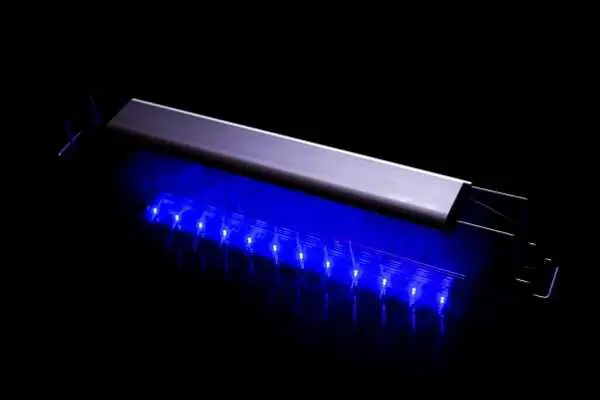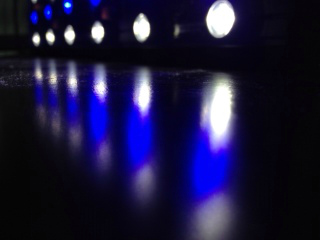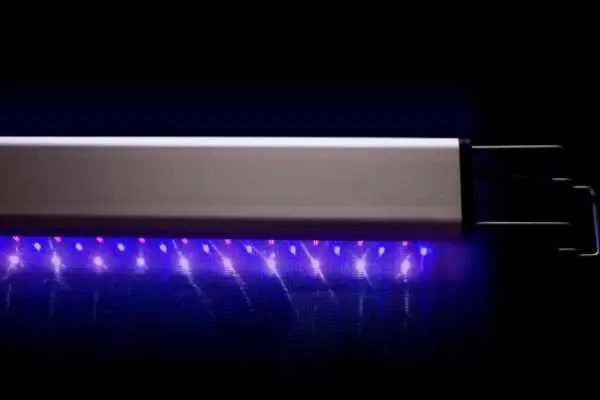If you spend any time looking over your electric bill, you know owning a saltwater aquarium can rack up significant costs. You’ve probably also heard that reef aquarium LED lights help cut down on the funds leaving your wallet every month. (As a matter of fact, one of the most popular articles I wrote discussed that fact) At the time, reef aquarium LEDs were just venturing onto the market. So I needed to invest in plenty of research. No biggie: I like research. (It’s part of my addiction to this hobby). Now that LEDs have become mainstream, it’s time to look at OTHER features besides saving some pennies – worthy as that feature may be.
Table of Contents: Reef Aquarium LED Lights
When I started looking into reef aquarium LED lights, I was working with an OLD light fixture running two 96-watt power compact lamps and a 175-watt metal halide. The lamps were shot; I needed to replace them. That’s when I started to consider LED alternatives. And once I dove into my research, that “gotta have it” bug infected my brain. And finding out I could save $340 a year in electricity costs? To say nothing of only needing to change a bulb ONCE a year? Yeah, I ended up hooked.
But then a comment from loyal reader Sam (thanks, Sam!) prompted me to look at other aspects of LEDs. And that’s where you’ll find these questions on reef aquarium LED lights coming from:
- Are Reef Aquarium LED Lights Suitable For Reef Tanks?
- How Expensive are Reef Aquarium LED Lights?
- How Long Do Reef Aquarium LED Lights Last?
- Can You Save Money by Switching to LED Lighting?
- How do You Pick the Right Reef Aquarium LED Lights?
- For More Information

Are Reef Aquarium LED Lights Suitable For Reef Tanks?
Everyone knows you can find excellent features when you look at LED lights. They come in various “temperatures” that allow you to create the perfect ambiance in your home. You can also find them in any color you want. Those aren’t standard features of your run-of-the-mill metal halide. But does that make them suitable for a reef tank? (Cool or not, you need to keep your corals happy)
As it turns out, the answer’s a resounding YES. Reef aquarium LED lights are perfect for any saltwater aquarium – including reef tanks. You get a wider range of color spectrum from the lighting (and not because you set the option to purple or blue), more power output without the heat. This yields a better environment within your tank. And not just for your delicate corals. Your fish don’t need to cope with water temperatures creeping up the closer they swim to those lights.

For example, I switched my lighting in 2013, and I can’t imagine using any other lights. There ARE some technical differences in the light output (I’ll get into that in a bit), but if I’m honest with you, I don’t notice a difference in performance. The lights switch on in the morning, shut off at night, and support coral growth throughout the day. What more could you want?
You don’t need to take my word for it, though. When reef aquarium LED lights hit the market, scientists started investigating them. Was the technology worth the hype? As it turns out – depending on the species, LEDs aren’t half-bad at boosting coral growth. It’s why most hobbyists these days make the switch.
How Expensive are Reef Aquarium LED Lights?
If you’ve swapped out the bulbs in your house, you know you need to spend more on LED technology. But there’s always a range. LEDs have been around long enough that they won’t break the bank – unless you decide you want a remote to change and program colors, a built-in speaker, or another smart feature. And the same goes for reef aquarium LED lights.
But that’s no different than most things in this hobby. You can spend as much money (or as little) as you want. Modular LED units pop up for under $50. If you look for earlier generation reef aquarium LED lights (note: they’re relatively weak), you’ll spend around $50-$150. Generic brands or lower-option lights usually run around $150-$300. Or you can splurge on premium brand fixtures for $450-$600. It depends on your budget, preferences for options or programmability, and how important name brands are to you.
All of the reef aquarium LED lights function the same way. So while you get options on the expense, you’ll get the same benefits. Do you get MORE with premium LEDs? Of course. But you don’t need to crack open your savings account to switch your reef tank over.

How Long Do Reef Aquarium LED Lights Last?
When you’re setting up your maintenance schedule, you need to consider the health of your lighting fixtures. As bulbs fade, they lose power. And that results in decreased health for your corals. One of the prominent features of LED lights is their longevity. Sure, you need to invest a little more in the purchase, but if you’re not replacing them constantly, isn’t that worth it? But how long is that longevity REALLY?
You need to look at the rating for your reef aquarium LED light. (Each brand’s different). But the standard claim is that a bulb should last for 50,000 hours when adequately cared for. What does that translate to in practical terms? If you run your lights for 10 hours a day, it’s almost FOURTEEN years! It’s fourteen times longer than metal halide bulbs. And it means you can set that “change bulb” reminder out pretty far on the calendar.
Now, not every light is rated to last that long. But even if your reef aquarium LED light lasts for 10,000 hours, you’re talking THREE years without a bulb change. LED lights should last you enough time to make the expense worth your while.

Can You Save Money by Switching to LED Lighting?
When you’re looking at plunking down MORE money to purchase reef aquarium LED lights, you want to know you’re getting a return on the investment. That’s a reasonable question to ask. Sure, your corals will grow better and look fantastic under the stronger lighting spectrum. But if they’ve survived this long without LED, is it worth it? You could always invest that money somewhere else to improve your reef tank.
Let me assure you, you’ll save money. You start saving money in places you don’t think to look:
- Your electric bill
- Replacement bulbs
- Chiller usage
Remember, reef aquarium LED lights draw less power, last longer, and don’t produce as much heat as metal halides or T5s. That means you’ll save money – down the road. It’s a cost-benefit situation. If you’re willing to wait a few months (or even a year) to recoup the expense of the lighting setup in the first place, you’ll get your savings reward. (I average $340 saved each year. Think of the potential fish, corals, or other tank equipment that can go to!)
How Do You Pick the Right Reef Aquarium LED Lights?
Now that reef aquarium LED lights have found their place in hobbyist fame, they’re everywhere. You see them stacked on the shelves in your local fish store (or even in chain pet stores) and offered online. Choosing the lighting option that works in your reef tank can get overwhelming. How to know which LED will suit your setup?
Honestly, any high-output reef-suitable lighting system will grow corals. There is no “right” or “perfect” LED light (despite what you might read in marketing materials). Each brand comes with pros and cons. Every technology is different, covering various spectrums and outputs. And the animals we keep in our tanks come from different parts of the ocean. What’s suitable for one species of coral won’t work for another (as you saw in that study). You’ll need to research the needs of the fish and invertebrates in your aquarium.

If you’re in the market for a new set of reef aquarium LED lights, though, I encourage you to search online. Look at the features, the size and shape of your tank, and the cost. Pick the light that meets your needs. I have a personal connection to ZOOMED and their AQUASUN LED light. ZOOMED’s sponsored this site from the beginning and provided me with the LED to test out. I don’t mind steering you in that direction, as I can certify personal experience with the lighting.
But like many things in this hobby, it’s not about the perfect choice. You want to create a dynamic, healthy environment for your critters. And you’ll only manage that with research and talking to others who’ve used the products before.
For More Information
More and more, aquarists are turning to reef aquarium LED lights. They find their tanks look better and thrive. And their electrical bills (and, thus, their bank accounts) don’t do too shabby, either. It’s the perfect example of embracing new technology. And if you need more information on the topic, you’ve come to the perfect place. After all, that’s why you popped onto this article, right?
If you’re REALLY interested in reef aquarium LED lights, this YouTube video will walk you through the entire spectrum and the resulting effects on coral growth (have popcorn and a comfy chair ready):
Or, if you want the Cliffs Notes version, you can stick to this video comparing different LED lighting options:
Another important factor in setting up your lighting in a reef tank is choosing the color. You can do that by mixing bulbs (yes, that means choosing an option other than reef aquarium LED lights). If you’re interested in getting the best growth and beauty out of your tank, Bulk Reef Supply walks you through everything you need to know.
Now that you’ve optimized your reef tank, why not dive into some of the best corals to stock that aquarium:


Leave a Reply